I’m sure many of us, as pet parents, have found ourselves in that moment of panic when we realize our fur-baby’s nails are getting a bit too long. The immediate thought that often springs to mind is: “Can You Cut Dog Nails With Human Nail Clippers?” Well, you’re in luck! Today on the blog, we’re diving deep into the topic of using human nail clippers on our canine companions. Whether you’re in a pinch or simply curious, I’m here to guide you through the process and answer that burning question. Let’s embark on this nail-trimming journey together and ensure that both you and your furry friend have a safe and comfortable experience! Stay tuned!

Is it okay to cut a dog’s nails with human nail clippers?
Many pet owners, at some point, have pondered this question. Before making any decisions, it’s essential to understand the differences between dog nails and human nails, as well as the tools designed specifically for each.
Anatomy of Dog Nails vs. Human Nails
- Dog Nails:
- Human Nails:
- Are flatter and less tough.
- Don’t have a quick, so there’s less risk when trimming.
The Concerns of Using Human Nail Clippers on Dogs
- Lack of Precision: Human clippers are designed for the flat profile of our nails. Using them on a rounded dog nail might not provide a clean, smooth cut.
- Risk of Splintering: The pressure from human nail clippers might cause dog nails to split or fracture.
- The Quick: Human clippers might not give you a good view of the quick, increasing the risk of accidentally cutting into it.
- Size of the Clippers: For larger dog breeds, human nail clippers might simply be too small to be effective.
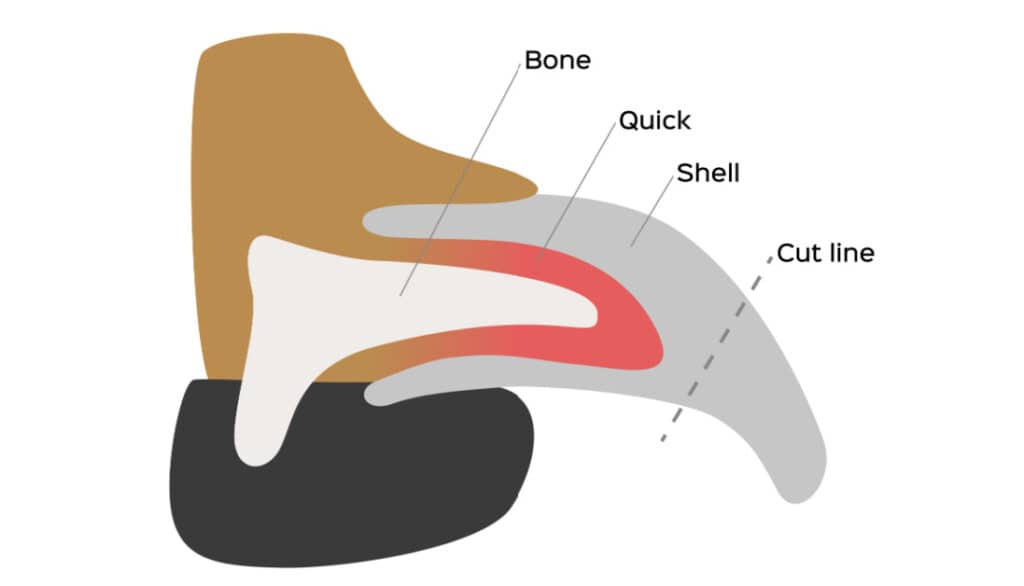
So, Can You Use Them?
While it’s possible to use human nail clippers on dogs, especially in a pinch or for smaller breeds with softer nails, it’s generally not recommended for regular grooming. The risks outweigh the benefits.
Better Alternatives
- Guillotine-style Clippers: Designed specifically for dogs, these provide a round cut ideal for the shape of dog nails.
- Grinder Tools: These are electric tools that grind down the nail, minimizing the risk of cutting the quick and offering a smoother finish.
- Professional Groomers: If you’re nervous about cutting your dog’s nails yourself, it might be worth investing in a professional’s service.
While our love for our pets often means we look for quick solutions in times of need, it’s essential to use the right tools for the job. For the sake of your dog’s comfort and safety, invest in proper grooming tools or seek professional assistance. Your furry friend will thank you!

Why use nail clippers designed for dogs?
Our dogs are not just pets; they’re family. As responsible pet parents, ensuring their well-being and comfort is our top priority. When it comes to grooming, particularly nail trimming, using the right tool is crucial. So, why should we opt for nail clippers designed specifically for dogs? Here’s a breakdown:
1. Anatomical Considerations
- Nail Structure: As discussed earlier, dog nails are thicker, tougher, and more rounded than human nails. Dog-specific clippers are designed to accommodate this unique structure.
- The Quick: Dog nails contain a quick that, if nicked, can lead to bleeding and pain. Dog clippers allow for more precision, reducing the risk of injury.
2. Safety and Comfort
- Grip and Control: Dog nail clippers typically come with ergonomic designs that provide a firmer grip, ensuring a stable hold and reducing the risk of accidental slips.
- Sharpness: They are specially crafted to cut through the hard texture of dog nails cleanly, minimizing splintering or splitting.
3. Efficiency
- Quick Trimming: Clippers for dogs are efficient and can trim nails quickly, reducing the stress and discomfort for your dog, especially if they’re nervous or restless.
- Variety for Different Breeds: Clippers come in various sizes and styles, ensuring that whether you have a Chihuahua or a Great Dane, there’s a tool tailored for your pet.
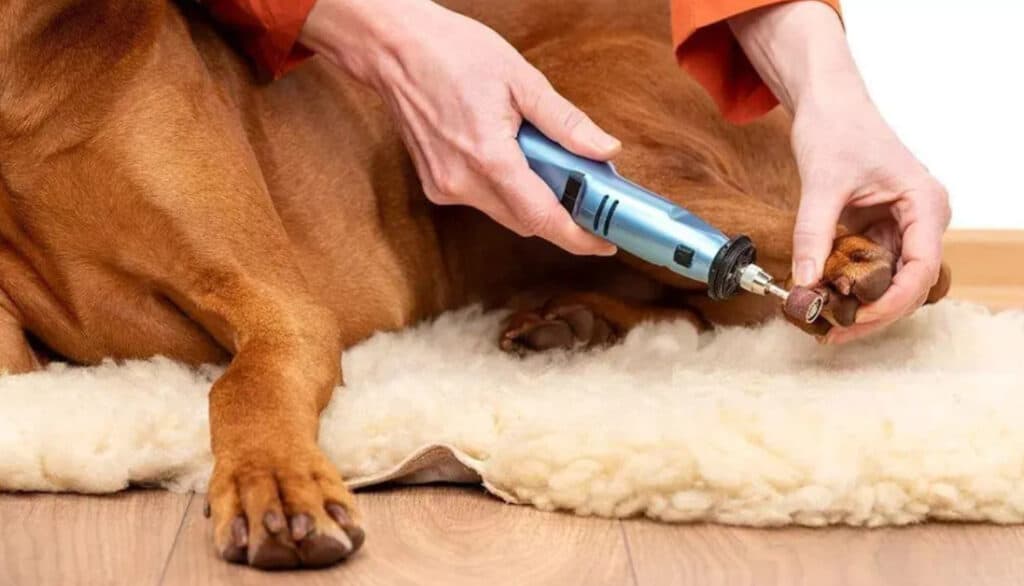
4. Durability
- Sturdy Materials: Dog nail clippers are typically made of high-quality stainless steel, ensuring they remain sharp and effective for longer periods.
- Long-term Investment: Given their durability, investing in a good pair of dog nail clippers means you won’t need to replace them frequently.
5. Added Features
- Safety Guards: Some clippers come with built-in safety guards to prevent over-cutting, which is particularly beneficial for those who are new to nail trimming.
- Lock Mechanisms: These ensure the clippers remain closed when not in use, reducing the risk of accidental injury.
- Comfort Handles: Many clippers have rubberized or padded handles, making them comfortable to use and reducing hand fatigue.
Choosing the right tools for our pets is a reflection of our commitment to their health and happiness. Nail clippers designed for dogs prioritize their unique anatomy, safety, and comfort, ensuring a stress-free grooming experience for both pet and owner. So, while it might be tempting to improvise with what’s on hand, investing in the proper equipment is a small gesture with significant benefits.

Risks of Using Human Nail Clippers On Your Dog
It’s a common misconception that because dogs and humans share similar basic nail structures, the tools used for grooming can be interchanged. However, this oversight could result in discomfort, injury, or long-term complications for your canine companion. Let’s delve into the potential risks of using human nail clippers on your dog.
1. Inadequate Trimming
- Uneven Cuts: Human nail clippers are flat, while dog nails are rounded. This mismatch can lead to uneven, jagged cuts.
- <strong>Insufficient Strength: Human clippers might not be strong enough to cut through a dog’s thicker nail, leading to partial cuts or multiple attempts to trim the same nail.
2. Nail Splintering and Fracturing
- Pressure Imbalance: Due to the design of human nail clippers, they might exert uneven pressure on a dog’s nail. This can cause the nail to splinter or fracture, potentially leading to infections.
3. Increased Risk of Cutting the Quick
- Reduced Visibility: The design of human nail clippers might obscure your view, increasing the chances of cutting into the quick. This not only causes bleeding but is painful for the dog.
- Lack of Safety Features: Unlike specialized dog nail clippers, which often come with safety guards, human clippers lack these protective features.
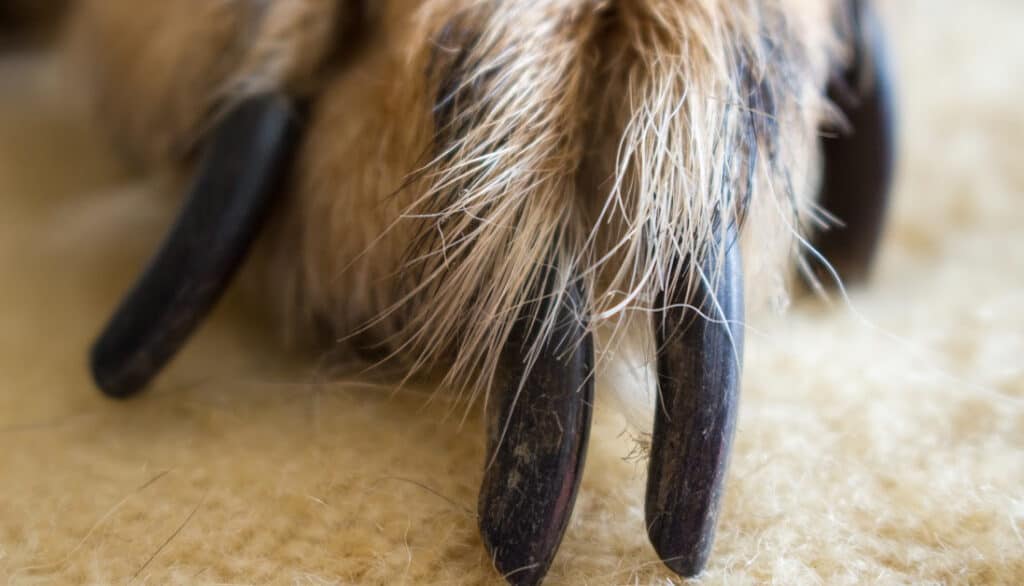
4. Potential for Injury
- Slips and Nicks: Human clippers aren’t designed for the curve and thickness of dog nails, increasing the chance of the clipper slipping and potentially injuring the dog or the person holding the clipper.
5. Stress and Discomfort for the Dog
- Prolonged Trimming: The inefficiency of human clippers might mean the process takes longer, which can be distressing for a dog, especially if they’re already anxious about nail trimming.
- Reinforcing Negative Associations: If using human clippers results in pain or discomfort, the dog might develop a negative association with nail trimming, making future grooming sessions challenging.
6. Potential for Infections
- Jagged Edges: Uneven cuts can create jagged edges, which can snag on surfaces. If torn, these can lead to open wounds and possible infections.
While it might seem like a convenient solution, using human nail clippers on your dog carries a range of risks, both for the dog’s physical health and their emotional well-being. It’s always best to prioritize their safety and comfort by investing in tools specifically designed for them or seeking professional grooming assistance.
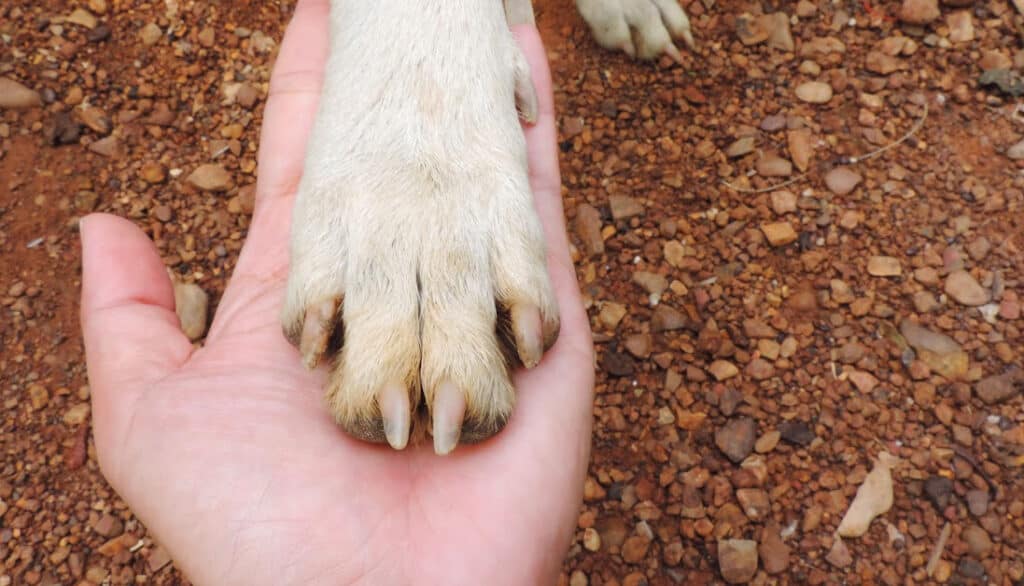
Can I File My Dog’s Nails With A Human File?
Filing is a common practice in human nail care to smooth out rough edges, but can the same be applied to our furry companions? Let’s explore the feasibility and considerations of using a human nail file on your dog.
1. Texture and Grit
- Human Nail Files: These are usually designed for the softer, thinner nails of humans. They may have a finer grit which might not be effective for the tough nails of dogs.
- Dog Nail Files: These are tailored for the harder texture of dog nails, often having a coarser grit to effectively smoothen and shape the nail.
2. Efficiency
- Time-Consuming: Using a human nail file might be more time-consuming because of its finer grit, which could be stressful for dogs that aren’t used to prolonged grooming sessions.
- Repeated Filing: Given the difference in grit, you might find yourself having to file repeatedly to achieve the desired smoothness with a human nail file.
3. Safety and Comfort
- Potential for Friction: A human file might generate more friction, which can cause discomfort or even heat up the nail if done vigorously.
- Handling: Dog-specific files are usually designed with longer handles to ensure a safe distance between the dog’s nail and your fingers, reducing the risk of nips or bites if the dog gets agitated.

4. Durability
- Wear and Tear: Because dog nails are tougher, using a human nail file might wear it out quicker than if used on human nails.
5. Practicality for Larger Breeds
- Insufficient Size: Human nail files might be too small or flimsy for larger dog breeds with thicker nails, making them impractical for effective filing.
While it’s technically possible to file your dog’s nails with a human nail file, especially in a pinch, it may not be the most efficient or comfortable method for your pet. If you do decide to use one, ensure you’re gentle and patient, periodically checking the nail’s temperature to prevent discomfort from friction. For regular grooming, consider investing in a dog-specific nail file or a grinder, which is designed with the anatomy and needs of dogs in mind. This will ensure a safer, quicker, and more pleasant experience for your furry friend.

How To Cut Dog Nails Without Clippers?
There are times when dog owners might not have specialized clippers on hand, or perhaps their dog has an aversion to them. In such cases, knowing alternative methods for trimming your dog’s nails can be a lifesaver. Let’s explore some safe and effective ways to cut dog nails without using clippers.
1. Nail Grinders or Dremels
- What Are They? These are electric tools that grind down a dog’s nails instead of clipping them. They’re especially useful for dogs with thick nails.
- Benefits:
- Gradual reduction of the nail length.
- Reduces the risk of cutting into the quick.
- Leaves a smoother finish.
- Considerations: Introduce the grinder slowly, as the vibration and noise might initially be unsettling for some dogs.
2. Nail Files
- How To Use: Just as you’d file human nails, you can file your dog’s nails. Use a gentle back-and-forth motion.
- Benefits:
- Controlled reduction of nail length.
- Can be less intimidating for dogs compared to clippers.
- Considerations: This method can be time-consuming, especially for dogs with harder nails. Ensure the file is coarse enough for your dog’s nails.
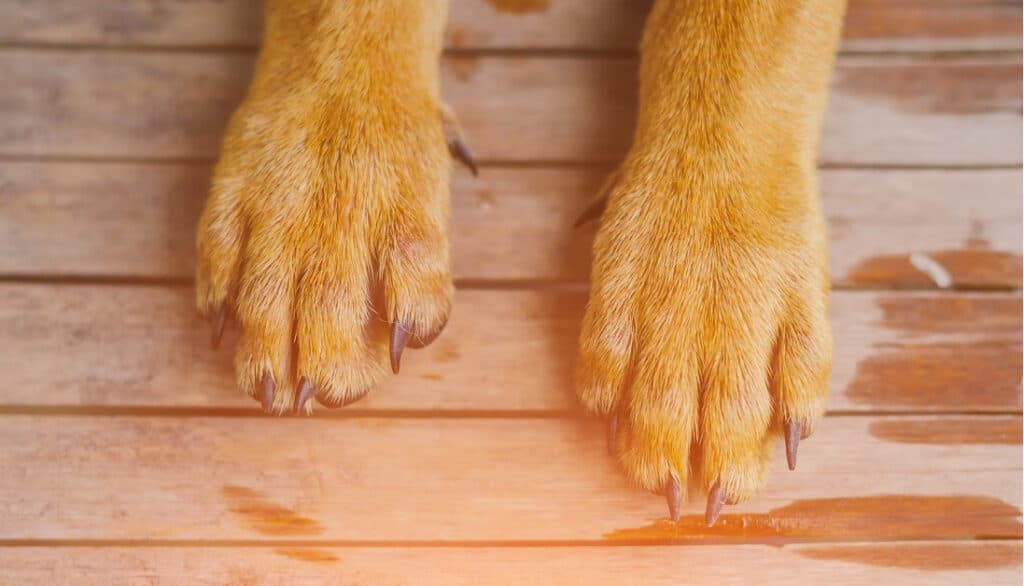
3. Regular Walks on Pavement
- How It Works: Walking your dog regularly on rough surfaces, like concrete or asphalt, can naturally file down their nails.
- Benefits:
- Passive nail trimming without active intervention.
- Great for dogs that are anxious about nail grooming.
- Considerations: This won’t replace regular nail trimming entirely, especially for the dewclaw, but it can extend the time between active grooming sessions.
Tips for Safe Nail Trimming Without Clippers:
- Go Slow: Whether you’re grinding, filing, or using any other method, take your time. The slower and more deliberate your actions, the less risk of injury.
- Frequent Checks: Always keep an eye on the nail’s quick, especially if you’re using an alternative method.
- Comfort is Key: Make sure your dog is calm and comfortable. Reward them with treats or praise during and after the session.
- Regular Maintenance: Even without clippers, maintaining a routine can help ensure your dog’s nails don’t become overly long.
While clippers designed for dogs are the go-to tool for many, it’s reassuring to know there are alternatives. Whether you choose to use a grinder, file, or simply engage in regular walks on pavement, always prioritize your dog’s comfort and safety. Remember, the goal is to make the experience as stress-free as possible for both of you.

Is It Better To Cut Or Grind Dog Nails?
Dog nail maintenance is an essential part of pet care, and owners often find themselves deciding between cutting and grinding. To make an informed decision, let’s compare both methods side by side.
1. Cutting Dog Nails
Using specialized dog nail clippers, the nails are snipped to the desired length.
| Pros | Cons |
|---|---|
| Quick process. | Risk of cutting the quick. |
| Clippers operate quietly. | Can leave jagged or sharp edges. |
| No need for electricity or batteries. | Some dogs dislike the pressure of the clippers. |
2. Grinding Dog Nails
Using a nail grinder or Dremel, the nails are gradually filed down to the desired length.
| Pros | Cons |
|---|---|
| Provides a smooth and rounded nail finish. | Some dogs are disturbed by the grinder’s noise and vibration. |
| Offers precision in nail trimming. | Process is more time-consuming than clipping. |
| Effective for dogs with thick nails. | Produces fine nail dust which can be bothersome. |
Factors to Consider:
- Dog’s Temperament: The choice might depend on whether your dog is more anxious about noises or the sensation of clippers.
- Owner’s Experience: Those new to dog nail grooming might find grinders offer a bit more control, while experienced owners might prefer the swiftness of clippers.
- Frequency of Grooming: Regular grooming might favor the speed of clippers, while occasional sessions could benefit from the finish grinders provide.
The decision to cut or grind your dog’s nails is contingent on both your pet’s preferences and your comfort with the tools. Some owners even combine the two, cutting nails first and then smoothing the edges with a grinder. Whichever method you choose, the main goal should always be the comfort and safety of your pet. Positive reinforcement, like praise and treats, can make the grooming experience pleasant for your furry friend.

Can You Cut Dog Nails With Scissors?
The idea of using scissors as a tool for trimming a dog’s nails may seem convenient, especially when dog-specific clippers aren’t immediately available. But is it a viable and safe option? Let’s delve into the feasibility and concerns of using scissors for this purpose.
1. Type of Scissors
While it’s possible to use scissors, not just any pair will do. The scissors would need to be:
- Sharp: A dull blade can cause crushing rather than cutting, leading to discomfort.
- Clean: Any tool used should be sanitized to reduce the risk of infection should there be any nicks or cuts.
- Sturdy: They need to be strong enough to handle the thickness of a dog’s nail without bending or breaking.
2. Safety Concerns
Using scissors comes with multiple risks:
- Lack of Precision: Scissors, especially large ones, might not provide the accuracy that dog nail clippers offer.
- Potential for Slips: Without the designed grip and shape of dog nail clippers, there’s a higher risk of the scissors slipping and causing injury.
- Risk of Splintering: A scissor’s straight cut might cause the nail to splinter, leading to further complications.
3. Comfort and Efficiency
- Potential for Pinching: Scissors might pinch the nail before cutting, causing discomfort.
- Multiple Cuts Needed: Unlike clippers that are designed to take off the desired length in one cut, scissors might require multiple snips, prolonging the process.
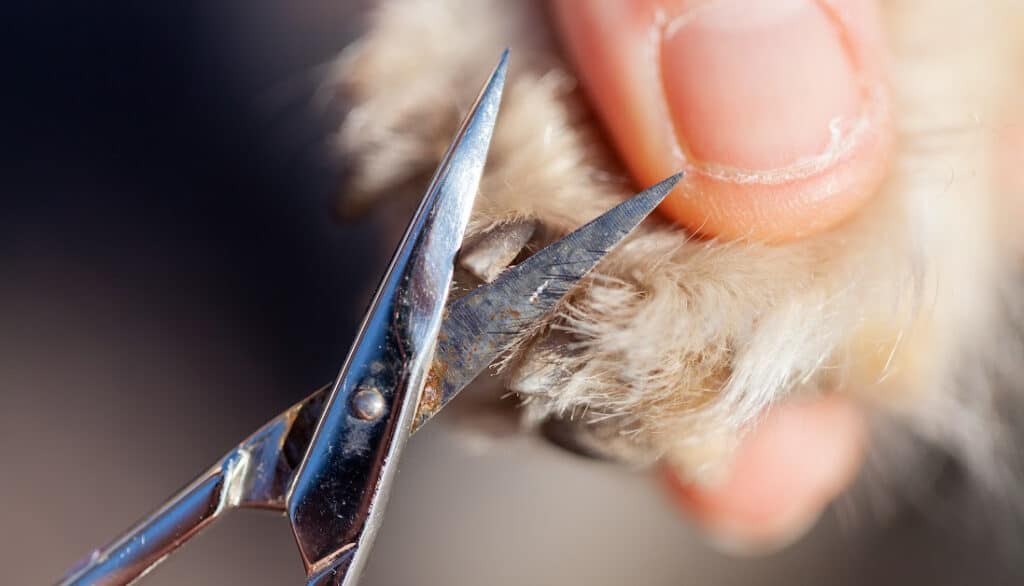
4. Suitability for Different Breeds
While scissors might be a makeshift tool for smaller breeds or puppies with softer nails:
- Not Ideal for Large Breeds: For bigger breeds with thicker nails, scissors are generally not practical or safe.
- Dewclaws: The location and angle of dewclaws can make them challenging to trim with scissors without causing discomfort.
5. Visibility of the Quick
- Obstructed View: Scissors might not give a clear view of the quick, increasing the risk of accidentally cutting it and causing pain and bleeding.
Tips if Opting for Scissors:
- Stay Calm and Steady: Ensure both you and your dog are calm. A jittery hand increases the risk of injury.
- Go Slow: Approach the process with patience. Aim for small cuts to avoid going too deep.
- Lighting: Ensure you’re in a well-lit environment to clearly see the nail and its quick.
- Have Styptic Powder on Hand: In case of any accidental cuts, having styptic powder can help stop bleeding.
While using scissors might seem like a quick solution, it’s fraught with risks that can lead to injury or trauma for your dog. If you find yourself without dog-specific clippers and feel the need to trim your dog’s nails, considering alternatives like nail grinders or filing may be safer. Always prioritize the safety and comfort of your canine companion. If in doubt, consult a professional groomer or veterinarian for guidance.
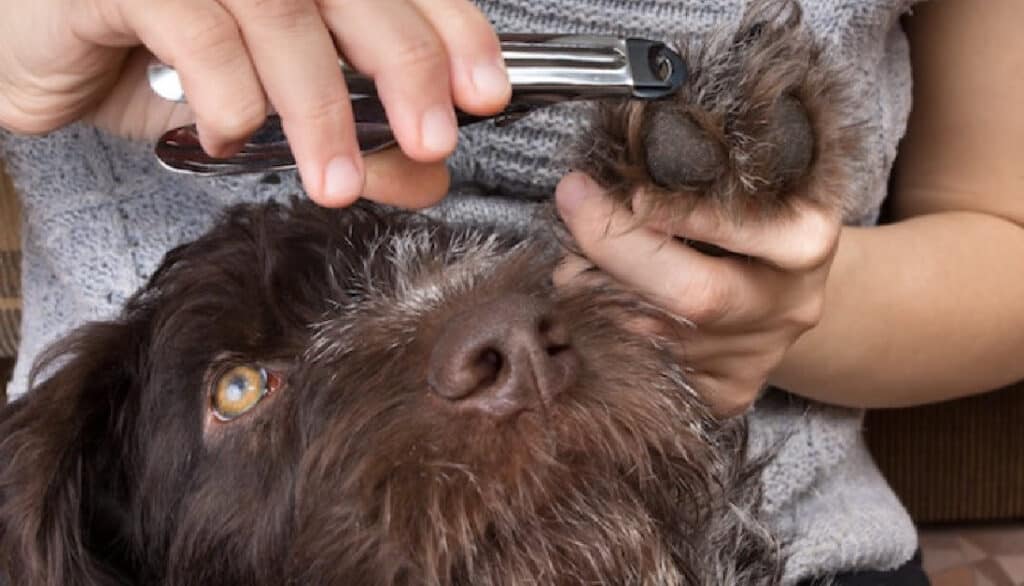
Can You Cut Dog Nails With Wire Cutters?
When faced with the task of trimming a dog’s nails and without the right tools at hand, some people might wonder about using wire cutters. While they may look somewhat similar to dog nail clippers, there are crucial differences. Here’s a look into the feasibility and concerns of using wire cutters for dog nails.
1. Design and Intended Use
Wire cutters are designed to cut wire, which requires a different kind of shearing force compared to cutting through the organic material of a dog’s nail. Dog nail clippers, on the other hand, are specifically crafted to handle the texture, thickness, and curvature of dog nails.
| Pros | Cons |
|---|---|
| Might be available in households. | Not designed for the texture or shape of dog nails. |
| Some might be sharp enough to cut through. | Can cause uneven or jagged cuts. |
2. Safety and Precision
Safety is a paramount concern when trimming a dog’s nails. The incorrect tool can increase the risk of injury or discomfort for the dog.
| Pros | Cons |
|---|---|
| – | High risk of cutting the quick. |
| – | Can cause splintering or splitting of the nail. |
| – | Might pinch or crush the nail due to design. |
3. Comfort for the Dog
The comfort of the dog during the nail trimming process is vital to ensure they don’t develop an aversion to nail grooming.
| Pros | Cons |
|---|---|
| – | Can be more painful than proper nail clippers. |
| – | Risk of causing trauma or stress to the dog. |
Factors to Consider:
- Urgency vs. Safety: If it’s urgent to trim a nail (e.g., a broken nail), and no other tools are available, you might be compelled to use what’s on hand. However, always consider the potential risks and discomfort.
- Dog’s Size and Nail Thickness: Wire cutters might be more dangerous for larger breeds with thicker nails due to the risk of crushing instead of cutting cleanly.
While wire cutters might seem like a potential alternative in a pinch, they are not recommended for cutting dog nails. Their design, intended use, and the risks they pose make them unsuitable and potentially harmful for this task. It’s always best to invest in tools specifically designed for the job or seek professional grooming services to ensure the safety and comfort of your pet. If ever in doubt, it’s always wise to consult a veterinarian or professional groomer.
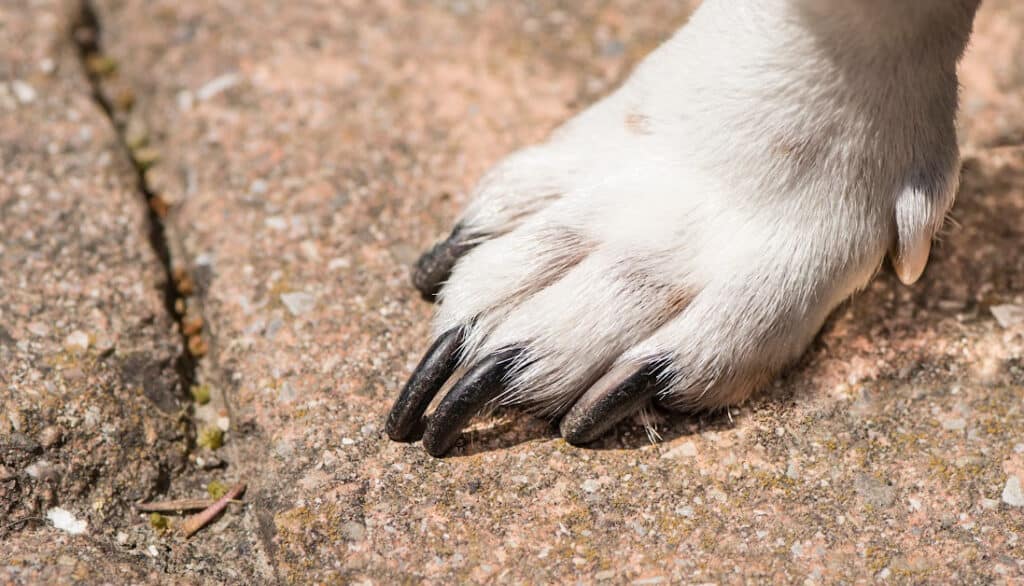
Conclusion
Navigating the world of dog nail care can be both a daunting and intricate journey. From understanding the right tools to use, to deciphering what’s myth from fact, our four-legged friends rely on us to make informed and compassionate choices for their well-being. While it might be tempting to use household tools or improvise in a pinch, it’s essential to remember that the safety and comfort of our pets should always be paramount. Specialized tools exist for a reason: to make the grooming process as smooth and stress-free as possible for both the dog and the owner.
Regular nail maintenance not only enhances your dog’s physical health but also strengthens the bond you share. It’s a moment of trust, a subtle dance of reassurance and care. So, the next time you find yourself reaching for those clippers or grinders, take a moment to appreciate the trust your pet places in you. Armed with knowledge, the right tools, and a sprinkle of patience, you’re well on your way to ensuring those paws are in tip-top shape.
Thank you for joining us on this journey of understanding and care. Remember, in the world of pet care, love, understanding, and a little bit of research can go a long way. Happy grooming! 🐾
Frequently Asked Questions (FAQs)
While some human tools may superficially resemble dog grooming tools, they aren’t designed for the specific needs and challenges of dog nails. Using inappropriate tools can increase the risk of injury or discomfort to your pet.
The frequency can vary depending on your dog’s activity level, age, and the surfaces they walk on. As a general rule, if you hear their nails clicking on the floor, it’s time for a trim. Typically, every 3-4 weeks is a common interval for many dogs.
First, don’t panic. While it might bleed and cause some discomfort, it’s a common mistake. Apply styptic powder or cornstarch to stop the bleeding and reassure your dog. If bleeding continues for an extended period, consult your veterinarian.
Absolutely. Some dogs might prefer nail grinding over clipping. Additionally, there are also anti-anxiety wraps and calming treats available. In extreme cases, you might want to consult your vet about sedative options or professional grooming services.
Long nails can cause discomfort, affect a dog’s posture and gait, and can even lead to injuries. Regular nail maintenance ensures your dog remains comfortable, healthy, and happy.
